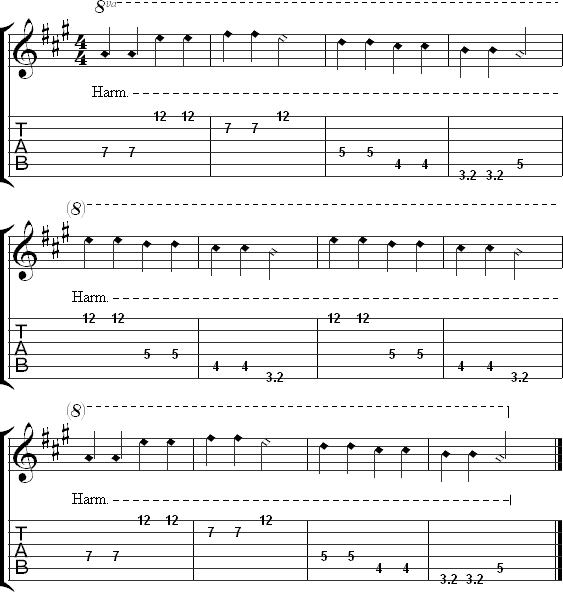What You Should Know
What You Will Learn
- How to play natural harmonics all over the neck
- How to play melodies in only natural harmonics
How to Find Harmonics All Over the Guitar Neck
Natural harmonics can be played at many frets other than the fifth, seventh, and twelfth frets. These other harmonics are a little more difficult to play because they are higher in the harmonic series, which means they are weaker harmonics. They require much more control over how you touch the string than the fifth, seventh and twelfth fret harmonics. You will likely need to experiment more with the exact pressure and position of the finger in order to get these harmonics to sound.
Fourth Fret Harmonics
The harmonic at the fourth fret is the fifth harmonic in the harmonic series. The pitch of the harmonic is two octaves and a major third above the open string. For example, the pitch of the fourth fret harmonic on the low E string is a G#.
Exercise 1
Exercise 1 is an ascending series of natural harmonics at the fourth fret. You may want to try playing the harmonic on each string repeatedly until you are able to get the harmonic to sound.
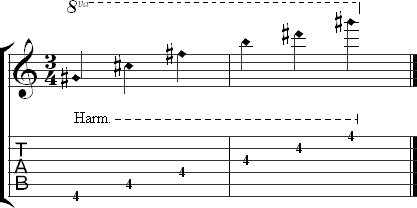
Exercise 2
Exercise 2 is similar to a harmonic riff that Joe Satriani plays in the intro to Summer Song. This riff works best with a distorted tone.
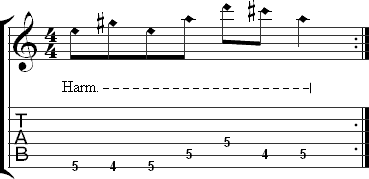
This harmonic also occurs at the ninth and sixteenth frets as well as somewhere between the end of the fretboard and the bridge (The exact location will depend on your guitar). The harmonic is usually played at the fourth fret due to its close proximity to the fifth and seventh fret harmonics.
3.2 Fret Harmonics
This is the sixth harmonic in the harmonic series. It occurs slightly after the third fret, roughly 2/10 of the way to the fourth fret. The harmonic is two octaves and a perfect fifth above the open string. For example, the pitch of the harmonic on the open A string will be E.
These imaginary fret numbers like 3.2, 2.8 and so on, are only approximations. You will need to experiment to get the exact location on your guitar.
Exercise 3
Exercise 3 includes a harmonic on every string at the 3.2 fret. You may find it very difficult to bring out this harmonic on the higher strings. Depending on your guitar, it may not be possible to get a strong harmonic on these strings.
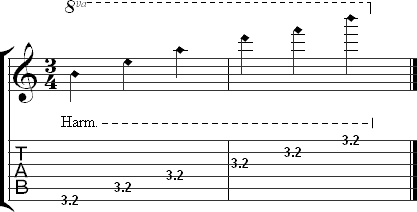
Starting with the sixth harmonic, all additional harmonics in the series are rather difficult to play. They require an extremely light touch and perfect positioning over the harmonic node. With harmonics up to the fifth harmonic in the series, you could get away with a somewhat inaccurate technique, but that will work against you in all harmonics beyond this. Make sure you experiment to find the exact location on the string where each harmonic occurs and try various degrees of pressure on the string.
Exercise 4
The harmonic at 3.2 allows you to play a major arpeggio on a single string by using it with the harmonics at the 4th and 5th frets. The root of the arpeggio is the same note as the open string. For example, this arpeggio played on the A string will produce an A major arpeggio.
Exercise 4 features a major arpeggio on the A string using these harmonics.
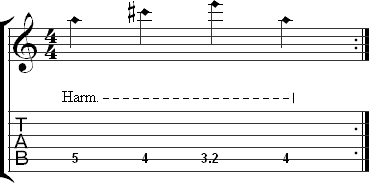
2.8 Fret Harmonics
This harmonic is the seventh harmonic in the series. It occurs between the second and third frets, but is closer to the third fret. The harmonic is usually notated at 2.7 or 2.8. It is two octaves and a minor seventh higher than the fundamental.
Exercise 5
Try playing this harmonic on each string in Exercise 5.
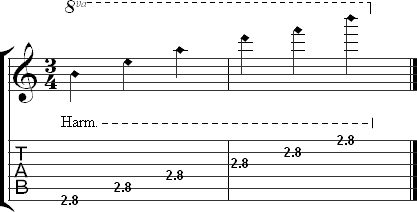
Exercise 6
It is possible to add this harmonic to the major arpeggio in Exercise 4 to create a dominant arpeggio. Exercise 6 demonstrates this with an A7 arpeggio on the fifth string. Try practicing this pattern of harmonics on each string.
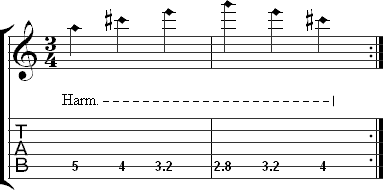
2.3 Fret Harmonics
The 2.3 fret harmonic occurs between the second and third frets about 3/10 of the way past the second fret. The pitch is three octaves higher than the fundamental.
Exercise 7
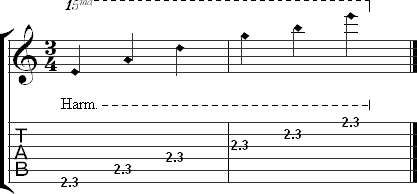
Exercise 8
By adding the 2.3 fret harmonic to the arpeggio from exercise 6, you can extended the dominant seventh arpeggio by one additional note. Exercise 8 shows this.
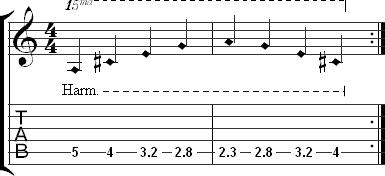
Additional Harmonics
Beyond the eighth harmonic, it gets fairly difficult to produce a usable harmonic even with the best technique and plenty of distortion. These harmonics work best on the thickest strings and may be impossible to produce on the higher strings.
Ninth Harmonic
The ninth harmonic is found over the second fret. Its pitch is three octaves plus a major second above the fundamental. For example, on the low E string, the pitch of the harmonic would be an F#.
Tenth Harmonic
The tenth harmonic is found between the first and second frets around 8/10 of the way to the second fret. It is usually notated at fret 1.8. The pitch is three octaves plus a major third above the fundamental. For example, on the low E string, the pitch of this harmonic would be a G# (an octave above the fourth fret harmonic).
Harmonics beyond this are possible, but they are so weak and difficult to bring out that they are rarely used.
Playing Melodies with Harmonics
Entire melodies can be played using natural harmonics, although the number of melodies is somewhat limited due to the lack of natural harmonics for certain pitches.
Twinkle Twinkle Little Star
Below is an arrangement of Twinkle Twinkle Little Star in natural harmonics. Practice slowly to get used to moving around the neck to play each harmonic. Try to get each harmonic to sound at an equal volume. This will mean applying a little extra force when playing some of the weaker harmonics, such as the 3.2 fret harmonic on the sixth string.
